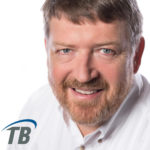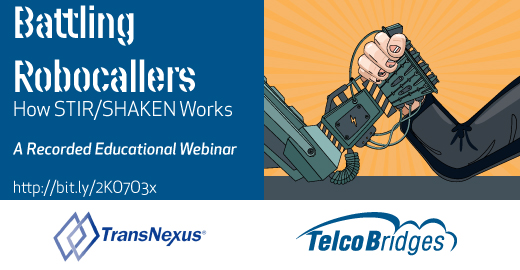 By Alan D. Percy, Senior Director of Product Marketing, TelcoBridges
By Alan D. Percy, Senior Director of Product Marketing, TelcoBridges
Last week we hosted a webinar with our Alliance Partner TransNexus, titled “Battling Robocaller Fraud – an Introduction to STIR/SHAKEN”. As we expected, the topic was wildly popular with a larger than normal audience attending the live event and a long list of great questions during the Q/A.
 As noted by Jim Dalton, CEO of TransNexus at the start of the session, automatic dialers with pre-programmed IVR scripts (aka Robocallers) do have valid applications (reminder calls from medical offices, bill pay reminders, school closures, reverse 911…) But they are increasingly being used as part of elaborate fraud schemes, bilking victims and stealing their identities. As noted by the Treasury Inspector General for Tax Administration (TIGTA), over 10,000 victims have collectively paid over $54 million because of phone scams since October 2013. And that’s just the crime that was reported.
As noted by Jim Dalton, CEO of TransNexus at the start of the session, automatic dialers with pre-programmed IVR scripts (aka Robocallers) do have valid applications (reminder calls from medical offices, bill pay reminders, school closures, reverse 911…) But they are increasingly being used as part of elaborate fraud schemes, bilking victims and stealing their identities. As noted by the Treasury Inspector General for Tax Administration (TIGTA), over 10,000 victims have collectively paid over $54 million because of phone scams since October 2013. And that’s just the crime that was reported.
What is STIR/SHAKEN?
In a nut-shell, STIR/SHAKEN is a framework that adds an encrypted identity certificate to the header of a SIP INVITE (the message that initiates the call), proving that the originator has permission to use the associated caller-ID.
Once the call makes its way through the various IP-based wholesale operators, the terminating operator can use a public key to examine the certificate and verify that the caller-ID is intact and rightfully being used by the originator. Calls with a valid certificate will pass to the recipient unimpeded and with the associated caller-ID, knowing it is valid. If a call arrives without a valid certificate, the terminating operator may flag the call as possible SPAM, send the call to a Captcha-like screening application or block the call altogether.
With literally billions of unwanted robocalls being made every month, they have become the largest source of complaints to the FCC, a very popular topic for a webinar and a great source of questions.
Here’s the Top 5 questions (and answers) from the “Battling Robocaller Fraud” webinar:
#1 How will stir/shaken affect class 4 telephony?
Answer: Implementing STIR/SHAKEN only impacts the originating and terminating carriers. The intermediary carriers (class 4) must pass the SIP identity headers without modification.
#2: Sounds great, but it depends entirely on the originating TSP to provide genuine authentication. What guarantees do we have this will be done by all originating TSPs, especially cellular carriers? What about calls that originate outside the US?
Answer: As the terminating service providers begin to flag calls without certificates as potential SPAM, or begin screening calls, the originators (both domestic and foreign) will have a strong incentive to add certificates to their calls. One of the beauties of STIR/SHAKEN is that the originators of bogus calls can be quickly found and dealt with by the regulators, making enforcement pretty easy.
#3: Does STIR/SHAKEN work only on the PSTN using SS7? What about OTT calls?
Answer: STIR/SHAKEN depends on IP infrastructure and the certificate is lost when handing a call over to a legacy TDM network. However, calls without a certificate can be flagged in the caller-ID by adding/substituting text in the caller-ID fields. Other applications like Skype SIP trunks could pass this information too.
#4: Does the size of the SIP packet require carriers to use TCP instead of UDP?
Answer: No, the identity certificates do fit within a SIP/UDP INVITE packet. However, there is a trend to consider SIP/TCP to handle traffic in the future.
#5: What role does TelcoBridges FreeSBC or Tmedia Gateways play?
Answer: When a call is originated, either the SBC or gateway passes the INVITE to the Authentication Server, which returns a signed SIP token to the SBC/gateway before passing the call to the network.
There were many more great questions (22 in all!) – take a listen to the recorded webinar, available now in the FreeSBC Video Library
More insight into STIR/SHAKEN can be found in an Understanding STIR/SHAKEN article by TransNexus article

Interested in integrating STIR/SHAKEN into your network? Request a consultation at the Discover SHAKEN workshop from TransNexus.



 by Alan Percy
by Alan Percy



 A root of the problem is the ease at which bulk phone calls can be made with spoofed caller-ID information, tricking unsuspecting victims to answer call they think are from friends or neighbors. While there are legitimate reasons to substitute caller-ID information (Doctors office reminders, school notifications, etc) fraudulent abuse continues to be an industry-wide problem.
A root of the problem is the ease at which bulk phone calls can be made with spoofed caller-ID information, tricking unsuspecting victims to answer call they think are from friends or neighbors. While there are legitimate reasons to substitute caller-ID information (Doctors office reminders, school notifications, etc) fraudulent abuse continues to be an industry-wide problem.






 I may get it made into a bumper sticker) With this tight-knit group all under one roof, and many of whom complete with similar solutions, there are plenty of opportunities for friction. I had plenty of opportunities to meet and talk with nearly everyone else – building some great new relationships and share what TelcoBridges had to offer the open-source community.
I may get it made into a bumper sticker) With this tight-knit group all under one roof, and many of whom complete with similar solutions, there are plenty of opportunities for friction. I had plenty of opportunities to meet and talk with nearly everyone else – building some great new relationships and share what TelcoBridges had to offer the open-source community.
 As noted by Jim Dalton, CEO of TransNexus at the start of the session, automatic dialers with pre-programmed IVR scripts (aka Robocallers) do have valid applications (reminder calls from medical offices, bill pay reminders, school closures, reverse 911…) But they are increasingly being used as part of elaborate fraud schemes, bilking victims and stealing their identities. As noted by the Treasury Inspector General for Tax Administration (TIGTA), over 10,000 victims have collectively paid over $54 million because of phone scams since October 2013. And that’s just the crime that was reported.
As noted by Jim Dalton, CEO of TransNexus at the start of the session, automatic dialers with pre-programmed IVR scripts (aka Robocallers) do have valid applications (reminder calls from medical offices, bill pay reminders, school closures, reverse 911…) But they are increasingly being used as part of elaborate fraud schemes, bilking victims and stealing their identities. As noted by the Treasury Inspector General for Tax Administration (TIGTA), over 10,000 victims have collectively paid over $54 million because of phone scams since October 2013. And that’s just the crime that was reported.